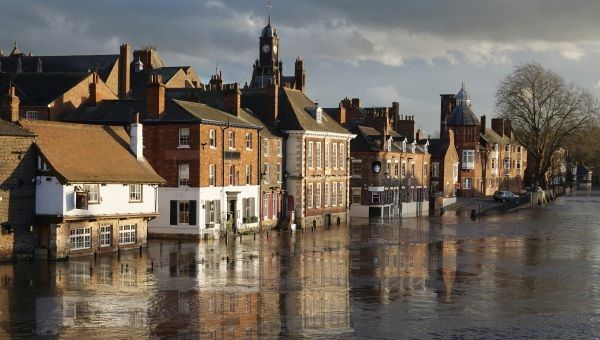Advancing cultural heritage governance for climate change adaptation
Centre for Enterprise and Entrepreneurship Studies: Dr Francesca Giliberto, 3 June 2024

Dr Francesca Giliberto is a Research Fellow in the Management department at Leeds University Business School. Her research interests include: cultural heritage governance; sustainable development; global challenges; urban heritage management; sustainable cities; international frameworks and local implementation.
Despite global commitments like the Paris Agreement and the United Nations’ Sustainable Development Goals (SDGs), progress towards necessary climate action has been inadequate in terms of speed, scale, and depth.
Climate change poses a significant challenge that intersects with social, economic, and environmental factors. However, traditional approaches to sustainability often fall short due to their narrow focus on technical solutions. This limited perspective inhibits the development of comprehensive, context-specific strategies.
In response, our new project - Advancing Cultural Heritage Governance for Resilient Climate Adaption (AGREE) - advocates for a transformative approach to sustainability, emphasising interdisciplinary collaboration and societal shifts. We plan on exploring the intricate relationship between cultural heritage governance, climate adaptation, and community resilience, particularly in urban areas vulnerable to flooding.
Cultural heritage governance and the need for systemic change
According to UNESCO, heritage is “our legacy from the past, what we live with today, and what we pass on to future generations." As such, the concept of heritage is a dynamic and evolving entity, intricately connected to individuals, communities and places, bridging past, present and future. It encompasses tangible elements such as monuments, historic buildings, sculptures and paintings, but also intangible aspects like social practices, traditions and values, collectively form this legacy.
The sustainable preservation of both cultural and natural heritage is included in SDG11 - “sustainable cities and communities”.
Currently, a more integral consideration of cultural heritage and its role in climate adaptation is held back by a strong ideology and organisational structure that opposes development and change. Commonly, climate change is seen as a threat to cultural heritage material and intangible attributes. This vision perpetuates reactive rather than proactive management practices.
The Historic Urban Landscape approach
We will be focusing on the systemic relationship between cultural heritage governance, climate adaptation, and community resilience, and in doing so, we will advance the UNESCO Historic Urban Landscape (HUL) approach. HUL is a landscape-based approach to urban heritage management that goes beyond traditional preservation efforts, integrating environmental, economic, and social sustainability.
It recognises that a city's cultural and natural significance is not just found in individual buildings or sites, but also in the overall urban fabric and its surroundings, including the intangible relationships between buildings, urban spaces, and the people who inhabit them.
The HUL approach aims to ensure that heritage preservation contributes to the vitality and resilience of urban communities in the face of current pressures such as climate change.
We will produce an innovative HUL-based decision-making model to visualize past and new urban and climate interdependencies, comparing current national and local policy discourses in different countries with historical data sources that reveal lessons in urban resilience reflected in local strategies and changes in the built environment over time.
Exploring responses to flooding
We will be using three case studies - Hull (UK), Lillehammer (Norway), and the Po riverside in Turin (Italy) - to explore responses to flooding in three urban contexts. These case studies will be used to analyse the intricate link between cultural heritage governance, climate adaptation and community resilience.
These three areas have been chosen as they represent diverse historic urban landscapes confronting flooding challenges in coastal, lake, and river settings. They provide unique insights into how local communities navigate flooding challenges within their cultural, geographical, and historical contexts, offering a comprehensive view of adaptive responses and innovative policies for environmental hazards and societal resilience in waterfront contexts.
Hull, UK City of Culture in 2017, is the UK’s second most vulnerable city to flooding, after London, primarily due to its low-lying position at the confluence of two rivers—the Hull and the Humber—and its proximity to the North Sea. With an 800-year history of managing water risks and several major floods documented in the city and regional archives, Hull provides an exemplary case study for understanding historical responses to recurrent flooding across different eras.
Lillehammer, renowned for landscapes and historical significance, was tested during recent catastrophic events like Storm Hans, showcasing local governance capacity for climate adaptation and risk management.
The Po riverside in Turin holds deep historical and cultural significance, marked by a legacy of wrestling with the Po River’s dual identity as both a crucial life source and a formidable threat, prominently underscored by the alternating challenges posed by the river flooding and periods of drought.
Next steps
We will be discussing our project’s strategies to address the challenges outlined above at the “Nature-Culture Relations” panel during the Sustainability Research and Innovation Congress (SRI) in June 2024 in Helsinki. This discussion is part of the Climate Cultural Heritage (CCH) 2023 kick-off meeting, organised by the Belmont Forum.
Visit the project webpage to keep up-to-date with our project activities. You can also join the AGREE LinkedIn group.
AGREE is funded by the Arts and Humanities Research Council - UK; Ministry of Education, Universities and Research (MUR) - Italy; and Research Council of Norway - Norway.
The views expressed in this article are those of the author and may not reflect the views of Leeds University Business School or the University of Leeds.
This blog post originally appeared on Leeds University Business School’s Research and Innovation Blog Link
